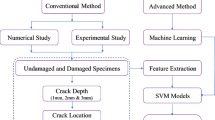Abstract
In this paper, a novel parametric model-based decomposition method is proposed for structural health monitoring of time-varying structures. For this purpose, the advanced Functional-Series Time-dependent Auto Regressive Moving Average (FS-TARMA) technique is used to estimate the parameters and innovation variance used in the parametric signal decomposition scheme. Additionally, a unique feature extraction and reduction method based on the decomposed signals, known as Latent Components (LCs), is proposed. To evaluate the efficiency of the proposed method, numerical simulation and an experimental study in the laboratory were conducted on a time-varying structure, where various types of damage were introduced. The Fuzzy Expert System (FES) was used as a classification tool to demonstrate that the proposed method successfully identifies different structural conditions when compared with other methods based on non-reduced and ordinary feature extraction.
Similar content being viewed by others
References
Akaike H (1977), “On Entropy Maximization Principle,” Applications of Statistics, 1(1):27–41.
Draper NR and Smith H (1998), Applied Regression Analysis, 3rd ed., New York: John-Wiley.
Huang NE (1998), “The Empirical Mode Decomposition and the Hilbert Spectrum for Nonlinear and Non-stationary Time Series Analysis,” Proceedings of the Royal Society of London Series, London, A 454, 903–995.
Kosko B (1997), Fuzzy Engineering, NJ: Prentice-Hall.
Li X and Du R (2005), “Condition Monitoring Using a Latent Process Model with an Application to Sheet Metal Stamping Processes,” Journal of Manufacturing Science and Engineering, ASME, 127:376–385.
Pawar PM and Ganguli R (2007), “Genetic Fuzzy System for Online Structural Health Monitoring of Composite Helicopter Rotor Blades,” Mechanical Systems and Signal Processing, 21: 2212–2236.
Poulimenos AG and Fassois SD (2003), “Estimation and Identification of Nonstationary Signals Using Functional Series TARMA Models,” Proceedings of the 13th IFAC Symposium on System Identification, Rotterdam, The Netherlands, 162–167.
Poulimenos AG and Fassois SD (2005), “On the Estimation of Nonstationary Functional Series TARMA Models,” Proceedings of the 13th European Signal Processing Conference, Antalya, Turkey.
Poulimenos AG and Fassois SD (2006), “Parametric Time-domain Methods for Nonstationary Random Vibration Modelling and Analysis — A Critical Survey and Comparison,” Mechanical Systems and Signa Processing, 20: 763–816.
Prado R (1998), “Latent Structure in Nonstationary Time Series,” PhD thesis, Institute of Statistics and Decision Sciences, Duke University.
Qian S and Chen D (1996), The Joint Time-frequency Analysis—Methods and Applications, Englewood Cliffs, NJ: Prentice-Hall.
Rahimi N, Sadeghi MH and Mahjoob MJ (2007), “Performance of the Geometric Approach to Fault Detection and Isolation in SISO, SIMO and MIMO Systems,” Journal of Zhejiang University Science A, 8(9):1351–1526.
Sadeghi MH and Fassois SD (1997), Geometric Approach to the Nondestructive Identification of Fault in Stochastic Structural Systems, AIAA Journal, 35(4): 700–705.
Sadeghi MH and Fassois SD (1998), “Reduceddimensionality Geometric Approach to Fault Identification in Stochastic Structural Systems,”, 36(12):2250–2256.
Sakellariou JS and Fassois SD (2006), “Stochastic Output Error Vibration-based Damage Detection and Assessment in Structures Under Earthquake Excitation,” Journal of Sound and Vibration, 297:1048–1067.
Serhat S and Emine A (2003), “Feature Extraction Related to Bearing Damage in Electric Motors by Wavelet Analysis,” Journal of the Franklin Institute, 340: 125–134.
Strang G and Nguyen T (1996), Wavelets and filter banks, Wellesley-Cambridge Press, USA.
Vincent HT, Hu S-LJ and Hou Z (1999), “Damage Detection Using Empirical Mode Decomposition Method and a Comparison with Wavelet Analysis,” Proceedings of the Second International Workshop on Structural Health Monitoring, Stanford, 891–900.
West M and Harrison PJ (1997), Bayesian Forecasting and Dynamic Models, 2nd ed., New York: Springer-Verlag.
West M, Prado R and Krystal AD (1999) “Evaluation and Comparison of EEG Traces: Latent Structure in Nonstationary Time Series,” Journal of the American Statistical Association (Applications and Case Studies), 94(446):375–387.
Yu Y, Dejie Y and Junsheng C (2006), “A Roller Bearing Fault Diagnosis Method Based on EMD Energy Entropy and ANN,” Journal of Sound and Vibration, 294: 269–277.
Zhan YM and Jardine AKS (2005), “Adaptive Autoregressive Mmodeling of Nonstationary Vibration Signals Under Distinct Gear States. Part 1: Modeling,” Journal of Sound and Vibration, 286: 429–450.
Zhan YM and Jardine AKS (2005), “Adaptive Autoregressive Modeling of Nonstationary Vibration Signals Under Distinct Gear States. Part 2: Experimental Analysis,” Journal of Sound and Vibration, 286:451–476.
Author information
Authors and Affiliations
Corresponding author
Rights and permissions
About this article
Cite this article
Ettefagh, M.M., Sadeghi, M.H. Health monitoring of time-varying stochastic structures by latent components and fuzzy expert system. Earthq. Eng. Eng. Vib. 7, 91–106 (2008). https://doi.org/10.1007/s11803-008-0785-z
Received:
Accepted:
Published:
Issue Date:
DOI: https://doi.org/10.1007/s11803-008-0785-z




